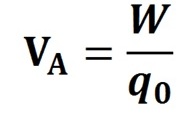Electric Potential – Simple experiment to measure it!
Hello friends of Steemit! I'm a Physics student next to graduate. One of the requirements for this is to fulfill a social task, called community service. I did this community service at the Udón Pérez school located in Maracaibo, Venezuela. Together with my colleagues, we elaborated a guide of simple experiments of physics, which we carried out in the laboratory of the educational institution.
On this occasion I want to share with you the practice concerning the electric potential, briefly explaining the theoretical foundations and then a simple experiment.

OBJECTIVE
- Analyze the potential and potential difference of a uniform electric field.
THEORY
ELECTRICAL POTENTIAL: The electric potential is in a point is defined as the work necessary to move the unit of positive charge from outside the field to that point. The equation corresponding to the electric potential at a point is:

where:
VA: Is the electric potential at a point of the electric field (volts).
W: The work to bring the charge from infinity to a point A (joules).
q0: Is the test load (coulombs).
POTENTIAL DIFFERENCE BETWEEN TWO POINTS: It is called the potential difference between two points A and B of an electric field, to the work per unit of charge that an external agent has to perform to carry out the positive charge unit from A to B, without changing the kinetic energy. According to this definition we can write that:

where:
VA-VB: Is the potential difference (volts).
WAB: The work to carry the positive charge unit from A to B (joules).
q0: Is the test load (coulombs).
This expression works in any situation.
DIFFERENCE OF POTENTIAL IN A UNIFORM ELECTRIC FIELD: In a uniform electric field originated by two parallel metal plates with equal and opposite charges, the potential difference between any two points taken one on each plate is equal to the product of the module E of the field intensity for the distance between the points.

where:
VB-VA: Is the potential difference (volts).
E: Is the electric field strength (Newtons/coulombs).
d: Is the distance between the plates (meters).
EQUIPOTENTIAL SURFACE: It is called equipotential surface to any surface that contains a continuous distribution of points that are at the same potential.

ELECTRICAL ENERGY: The electrostatic potential energy of a system is the work necessary to move the loads from an infinite separation to their final positions without acceleration.

where:
U: Is the electric potential energy (joules).
K: Is the coulomb law constant (9.109 Newtons.meters2/coulombs2).
q: Is the point charge (coulombs).
q0: Is the punctual charge (coulombs).
r: Is the distance between the charges (meters).
HOME EXPERIMENT
MATERIALS:
- Lemons.
- Galvanized nails.
- Copper coins.
- Cables.
- LED (bulbs).
- Voltmeter.
PROCESS:
Insert a coin on one side of the lemon and a nail on the other side. Repeat this with 3 additional lemons. With the voltmeter measure the potential generated for each lemon and write the results. Now build a series circuit using the lemons as shown in the figure:

Proceed to measure the potential at the end of the circuit.
The potential obtained with these 4 lemons will be almost 4 volts and this will allow us to turn on a Led. Interesting truth?
This is due to the fact that between the metals and the acid of the lemon, a chemical reaction takes place which in turn produces an electrical current in which case the current is not static, but it moves.
I wish you enjoyed the publication about the electric potential and that the information is useful to you. Thanks for your kind reading.
References:
[1] BRETT, E. y SUÁREZ, W. Física Teoría y Práctica 2do año Ciclo Diversificado. Editorial Discolar S.A. Caracas, 1998.
[2] Física, Tomo IV, Décima Quinta Edición. Editorial Grupo Escalera UNIVERSIDAD SIMON BOLIVAR.
[3] HEWITT, P. Física Conceptual 2da. Edición, Editorial Addison-Wesley Iberoamericana. EUA, 1999.
[4] RESNICK, R y HALLIDAY, D. Física. Tomo II, Segunda Edición. Editorial Continental S.A. México, 1977.
Good work. Congratulations.
thanks teacher ;) @emily61